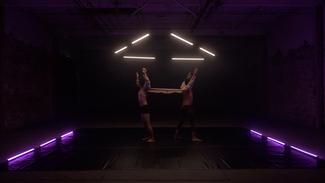
Video Room: Kang Seung Lee Kang Seung Lee
Dates : Vendredi 23 août 2024 - Dimanche 27 octobre 2024
Vernissage : Vernissage ven 23 Aoû 2024, 10:00
Adresse : MASP - Assis Chateaubriand Museum of Art of São Paulo, Avenida Paulista, 1578 - Bela Vista, 01310-200 São Paulo
MASP - Assis Chateaubriand Museum of Art of São Paulo
Avenida Paulista, 1578 - Bela Vista
01310-200 São Paulo, SP
São Paulo-SP
01310-200
Brésil
Description, horaires...
By evoking intimacy and affection, as well as states of suffering and belonging, the audiovisual work Lazarus (2023) pays homage to and reimagines the stories and experiences of the queer community in Video Room: Kang Seung Lee. The work, on show at MASP - Museu de Arte de São Paulo Assis Chateaubriand, from August 23rd, is also on display in the contemporary section of the 60th Venice Biennale.
Inspired by José Leonilson's Lásaro (1993) – an installation made of two shirts sewn together, considered to be the Brazilian artist’s last work – and the original ballet Unknown Territory (1986), by Singaporean choreographer Goh Choo San (1948-87), the video presents a duet of minimal and intentional movements. By replicating Leonilson’s work on Sambe, a hemp fabric traditionally used in Korea for funeral shrouds, the dancers interact, choreographing a tribute to the lives and memories lost during the HIV/AIDS epidemic, including those of both artists, who died of illnesses caused by the virus.
“I have always understood that my artistic work is influenced by people who came before us, especially in relation to the queer histories of different nations. I often research and reposition these narratives and archives, connecting different geographies and experiences, and I believe there is a possibility of creating new knowledge in this process,” reflects Kang Seung Lee.
Curated by Amanda Carneiro, curator, MASP, the show features yet another work by Kang Seung Lee. Untitled (Lazaro, Jose Leonilson, 1993) (2023) is made up of different materials – graphite, pearls, parchment, a piercing needle and old 24K gold thread – together with a drawing of the sculptural garment created by Leonilson. The work Lásaro, by the Brazilian artist, can be seen at the same time as Lee’s work, in the exhibition Leonilson: agora e as oportunidades, on the second floor of MASP. “Lee associates fragments of a kind of material history of the world with subjective stories, above all of homosexual men who died because of the AIDS crisis, exalting their stories. His work evokes an idea of fragility while at the same time highlighting the narrative power of these encounters,” says Carneiro.
Untitled (Lazaro, Jose Leonilson, 1993) was incorporated into MASP’s collection as part of the museum’s efforts to internationalize its contemporary art collection.
In 2024, the Video Room program is part of the cycle of Histories of LGBTQIA+ Diversity at MASP, which has already presented exhibitions by Masi Mamani/Bartolina Xixa, Tourmaline and Ventura Profana, and will screen the audiovisual production by Manauara Clandestina.
ABOUT KANG SEUNG LEE
By exploring images, public and private texts, artifacts and objects from archives, art collections, libraries and queer archives, multidisciplinary artist Kang Seung Lee dedicates his work especially to the legacy of LGBTQIA+ people, highlighting voices and counter-narratives that are often neglected.
Kang Seung Lee (Seoul, South Korea, 1978) lives in Los Angeles and his work has been included in international exhibitions such as the 60th Venice Biennale (2024); Made in LA, at the Hammer Museum (2023); New Museum Triennial (2021); and Gwangju Biennale (2021). He also took part in documenta fifteen (2022). The artist has held solo exhibitions and projects at institutions such as the National Museum of Modern and Contemporary Art in Seoul (2023); Vincent Price Art Museum in Los Angeles (2023); 18th Street Arts Center in Santa Monica, CA (2020); Artpace in San Antonio (2017) and Pitzer College Art Galleries in Claremont (2015). His work is included in the collections of the Getty Research Institute, Hammer Museum, National Museum of Modern and Contemporary Art, Solomon R. Guggenheim Museum and MASP.